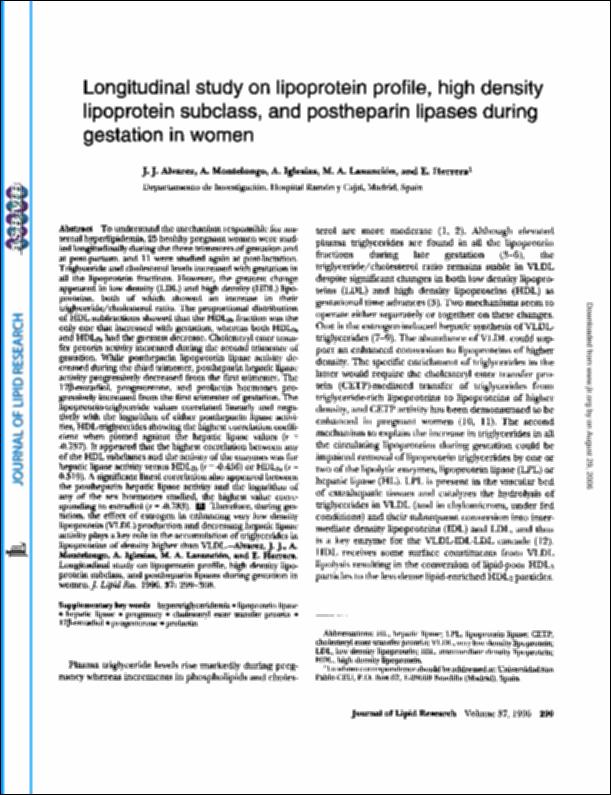Please use this identifier to cite or link to this item:
http://hdl.handle.net/10637/626Longitudinal study on lipoprotein profile, high density lipoprotein subclass, and postheparin lipases during gestation in women.
| Title: | Longitudinal study on lipoprotein profile, high density lipoprotein subclass, and postheparin lipases during gestation in women. |
| Authors : | Álvarez Millán, Juan José Montelongo, Adela Iglesias, Miguel A. Lasunción, Miguel Ángel. Herrera Castillón, Emilio. |
| Keywords: | Hypertriglyceridemia.; Lipoprotein lipase.; Hepatic lipase.; Pregnancy.; Cholesteryl ester transfer protein.; 17Bstradiol.; Progesterone.; Prolactin. |
| Abstract: | To understand the mechanism responsible for maternal hyperlipidemia, 25 healthy pregnant women were studied longitudinally during the three trimesters of gestation and at post-partum, and 11 were studied again at post-lactation. Triglyceride and cholesterol levels increased with gestation in all the lipoprotein fractions. However, the greatest change appeared in low density (LDL) and high density (HDL) lipoproteins, both of which showed an increase in their triglyceride/ cholesterol ratio. The proportional distribution of HDL subfractions showed that the HDL2b fraction was the only one that increased with gestation, whereas both HDL.sa and HDLsb had the greatest decrease. Cholesteryl ester transfer protein activity increased during the second trimester of gestation. While postheparin lipoprotein lipase activity decreased during the third trimester, postheparin hepatic lipase activity progressively decreased from the first trimester. The 17J3-estradiol, progesterone, and prolactin hormones progressively increased from the first trimester of gestation. The lipoprotein-triglyceride values correlated linearly and negatively with the logarithm of either postheparin lipase activities, HDlrtriglycerides showing the highest correlation coefficient when plotted against the hepatic lipase values (r = -0.757). It appeared that the highest correlation between any of the HDL subclasses and the activity of the enzymes was for hepatic lipase activity versus HDL2b (r = -0.456) or HDLsa (r = 0.519). A significant lineal correlation also appeared between the postheparin hepatic lipase activity and the logarithm of any of the sex hormones studied, the highest value corresponding to estradiol (r = -0.783). Ill Therefore, during gestation, the effect of estrogen in enhancing very low density lipoprotein (VLDL) production and decreasing hepatic lipase activity plays a key role in the accumulation of triglycerides in lipoproteins of density higher than VLDL. |
| Description: | En: Journal of lipid research. 1996. N. 37 : 299-308 p. 0022-2275 |
| URI: | http://hdl.handle.net/10637/626 |
| Rights : | http://creativecommons.org/licenses/by-nc-nd/4.0/deed.es |
| Issue Date: | 19-Sep-1996 |
| Center : | Universidad San Pablo-CEU |
| Appears in Collections: | Facultad de Farmacia |
Items in DSpace are protected by copyright, with all rights reserved, unless otherwise indicated.


